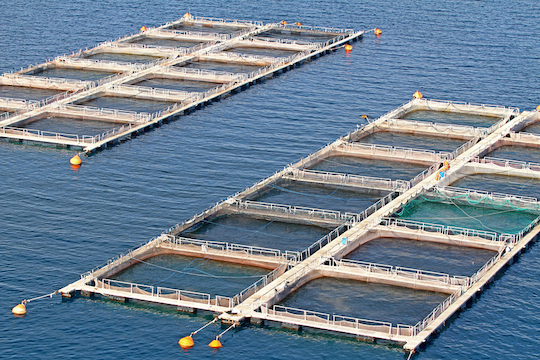The fish-farming industry is increasing its use of
plant-based ingredients in its feed and moving away from traditional feed made
from fish, which could impact some of the health benefits of eating certain
types of seafood, suggests a new analysis from the Johns Hopkins Center for a
Livable Future (CLF) at the Johns Hopkins Bloomberg School of Public Health.
The findings are published March 11 in the journal
Environment International.
Half of the seafood consumed by Americans is farmed.
Fish farming, also known as aquaculture, is the fastest-growing food animal
sector, outpacing the beef and poultry industries. While wild fish find their
own food -- which includes smaller fish for carnivorous species -- intensively
farmed fish are fed a manufactured aquaculture feed. Until recently, this
manufactured feed was typically composed of high levels of fishmeal and fish
oil derived from wild fish -- but it has become unsustainable to catch more
wild fish to feed growing numbers of farmed fish, so the industry has shifted
the makeup of the feed. For example, twice as much soybean meal was used in
commercial aquaculture feed in 2008 as compared to fishmeal, and the use of
crop-based ingredients is projected to increase 124 percent between 2008 and
2020.
"Farmed fish get their health-promoting omega-3
fatty acids, EPA and DHA, from their feed, and specifically from fish
oil," says study leader Jillian Fry, PhD, director of CLF's Public Health
and Sustainable Aquaculture Project and a faculty member at the Bloomberg
School. "Our review found that increasing plant-based ingredients can
change the fatty acid content in farmed fish, which can affect human
nutrition."
The new study details the industry shift to
crop-based feed ingredients, such as soy, corn, and wheat, to replace wild fish
as a key ingredient in manufactured feed. The researchers -- in collaboration
with colleagues from the University of Minnesota's Institute on the Environment
and McGill University -- reviewed aquaculture and public health literature, and
conducted a new analysis to estimate the environmental footprint for the top
five crops used in commercial aquaculture feed.
The shift has been hailed by some as a positive
change in light of the increasingly depleted oceans and the rapidly expanding
aquaculture industry. But the shift may have some unintended consequences as
well.
Using vegetable oils instead of fish oil changes the
fatty acid content of fish and nutritional value for human consumption, the
researchers say. Considering Americans are encouraged to consume seafood high
in omega-3 fatty acids, which promote improved cardiovascular health and
neurodevelopment, this has large implications for dietary recommendations and the
aquaculture industry. More research is needed, they say, to better understand
the impact of this shift in feed on the health benefits of consuming farmed
fish.
While fish-based ingredients are seen as acutely
limited, so are the resources such as land, water and fertilizer used to
produce feed crops. Aquaculture's environmental footprint likely now includes
increased nutrient and pesticide runoff from the industrial crop production
needed to supply fish food. This runoff is a key driver of water pollution
globally, and can negatively impact public health. Depending on where and how
feed crops are produced, plant-based fish feed could be indirectly linked to
negative health outcomes for agricultural workers and nearby communities due to
exposure to air, water or soil contaminated by nutrients and/or pesticides.
Fry says that these new findings may raise more
questions than they answer.
"The nutritional content of farmed fish should
be monitored," Fry says. "The aquaculture industry should assess the
environmental footprint and public health impacts of their crop-based feed
ingredients and seek those produced using sustainable methods."
Story Source:
The above post is reprinted from materials provided
by Johns Hopkins University Bloomberg School of Public Health. Note: Materials
may be edited for content and length.






